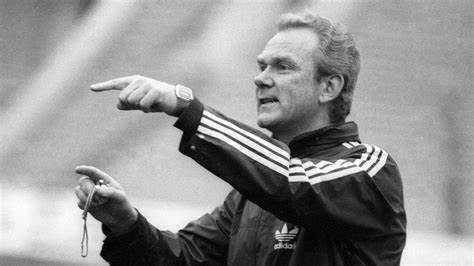Valeri Lobanovskiy: The Tactical Visionary Who Changed Soviet Football
He was one of the most influential football managers of the 20th century. He revolutionised the tactical landscape of Soviet and Eastern European football. Known for his systematic approach, Lobanovskiy introduced groundbreaking methods. These methods reshaped the way football was played, particularly with Dynamo Kyiv and the Soviet national team. His commitment to science, fitness, and discipline laid the foundation for the modern tactical evolution we see in football today.

Lobanovskiy's Tactical Philosophy: A Blend of Science and Discipline
Lobanovskiy’s football philosophy was built on scientific principles, intense physical conditioning, and tactical intelligence. He was one of the first coaches to integrate sports science into his training methods and believed in the following key principles:
Physical Conditioning:
Lobanovskiy placed great emphasis on stamina, endurance, and mental resilience. His players were some of the fittest in Europe, capable of maintaining high-intensity play throughout a match.
Tactical Discipline:
His teams adhered to strict positional play, with each player understanding their role within the system. Every movement was designed to be part of a greater collective effort.
Total Team Play:
Lobanovskiy’s football was collective rather than individualistic, where each player contributed to both defensive and offensive phases. His formations were highly structured but allowed for fluid transitions between defence and attack.
Dynamo Kyiv: The Birth of a Tactical Revolution
Lobanovskiy’s greatest achievements came during his time with Dynamo Kyiv. Under his leadership, the team became one of Europe’s most dominant sides, winning multiple Soviet league titles, domestic cups, and two European Cup Winners’ Cups (1975 and 1986). Lobanovskiy’s Dynamo Kyiv was known for its disciplined, high-pressing style and the systematic implementation of tactics:
- 4-4-2 Formation: Lobanovskiy employed a 4-4-2 formation with well-defined roles for every player. The midfielders worked in tandem, supporting both defensive duties and offensive transitions.
- High Pressing: His teams played an aggressive, high-pressing game, aiming to win the ball back high up the pitch. This early form of pressing has been credited as a precursor to modern high-press systems employed by teams like Barcelona and Bayern Munich.
- Speed and Precision: Lobanovskiy emphasised quick, short passes and fast counter-attacks. His team’s ability to transition from defence to attack in an instant was one of their trademarks.
Soviet National Team: Tactics on the Global Stage
Lobanovskiy’s influence extended beyond club football to the Soviet Union national team, where he introduced similar tactical principles. His tenure with the national team saw:
The 1980 European Championship:
Under Lobanovskiy, the Soviet Union reached the final of the 1980 European Championship. The team played with a highly structured, disciplined approach, utilising the same high-press and counter-attacking tactics that had served him so well at club level.
1986 World Cup:
Lobanovskiy’s tactical influence was evident during the 1986 World Cup, although the Soviet Union was eliminated in the quarter-finals. Nevertheless, his team’s organisation, pressing, and fast transitions left a lasting impression on football analysts worldwide.
Key Tactical Innovations of Lobanovskiy
Scientific Approach to Training:
Lobanovskiy integrated sports science into every aspect of his coaching, from fitness regimes to match preparation. He was one of the first to analyse players’ performances using data, emphasising recovery and physical conditioning to ensure peak performance levels.
Compact Defending and Fluid Attacking:
His teams maintained a compact defensive shape but were highly fluid in their offensive movements. Lobanovskiy often had his midfielders and forwards interchange positions to create overloads and disrupt opposition defences.
Pressing and Collective Defence:
Lobanovskiy was a pioneer of the high pressing game. He stressed the importance of team organisation and quick decision-making, with players working collectively to regain possession and launch fast counter-attacks.
Dynamo Kyiv's Tactical Legacy
Under Lobanovskiy, Dynamo Kyiv was a footballing powerhouse. His tactical methods not only brought success to the club but also influenced future generations of coaches:
European Cup Winners' Cups:
Dynamo’s triumphs in the 1970s and 1980s, especially their 1975 European Cup Winners’ Cup win, demonstrated the effectiveness of Lobanovskiy’s pressing, counter-attacking style on the international stage.
Exporting Soviet Football Tactics:
The tactical blueprint Lobanovskiy developed in Kyiv was later adopted by many top European managers, including those in the Soviet bloc countries, and influenced coaching ideologies across Europe.
The Influence of Lobanovskiy's Tactics on Modern Football
Lobanovskiy’s tactical innovations continue to influence football today. His ability to blend scientific approaches with strict tactical discipline paved the way for the modern game’s emphasis on high pressing, collective team play, and fitness:
- High Pressing: Lobanovskiy’s early work on pressing from the front has evolved into the modern pressing systems we see in clubs like Liverpool, Bayern Munich, and Manchester City. His vision of regaining possession high up the pitch has become a fundamental aspect of contemporary football.
- Structured Team Play: The idea that every player must understand their tactical role in the system has been widely adopted by top coaches such as Pep Guardiola, who also emphasises tactical discipline and positional play in his teams.
- Data-Driven Football: Lobanovskiy was ahead of his time in integrating data and sports science into football. Today, nearly every top club uses analytics and fitness tracking to optimise player performance, a concept Lobanovskiy helped pioneer.
Key Players in Lobanovskiy's System
Lobanovskiy’s success was built on the strength of his players, each of whom was vital to the implementation of his tactical vision:
Oleg Blokhin:
The dynamic forward was one of Lobanovskiy’s most important attacking players. His speed and finishing ability made him a constant threat in Lobanovskiy’s high-pressing system.
Valery Lobanovskiy’s Midfield General:
Players like Igor Belanov and Yuri Semyonov were crucial in both offensive and defensive phases, ensuring balance in Lobanovskiy’s tactical setup.
Oleg Blokhin:
As a key defensive midfielder, Shestilov’s role in breaking up opposition attacks and distributing the ball effectively allowed Lobanovskiy’s teams to control the game.
Legacy: A Tactical Visionary
Valeri Lobanovskiy’s legacy is immeasurable. His methods laid the groundwork for much of modern football’s tactical evolution. This includes the emphasis on pressing, team organisation, and scientific training. While not as widely celebrated in the West during his time, Lobanovskiy’s work had a profound influence on football’s tactical development. His contributions continue to inspire coaches today.

